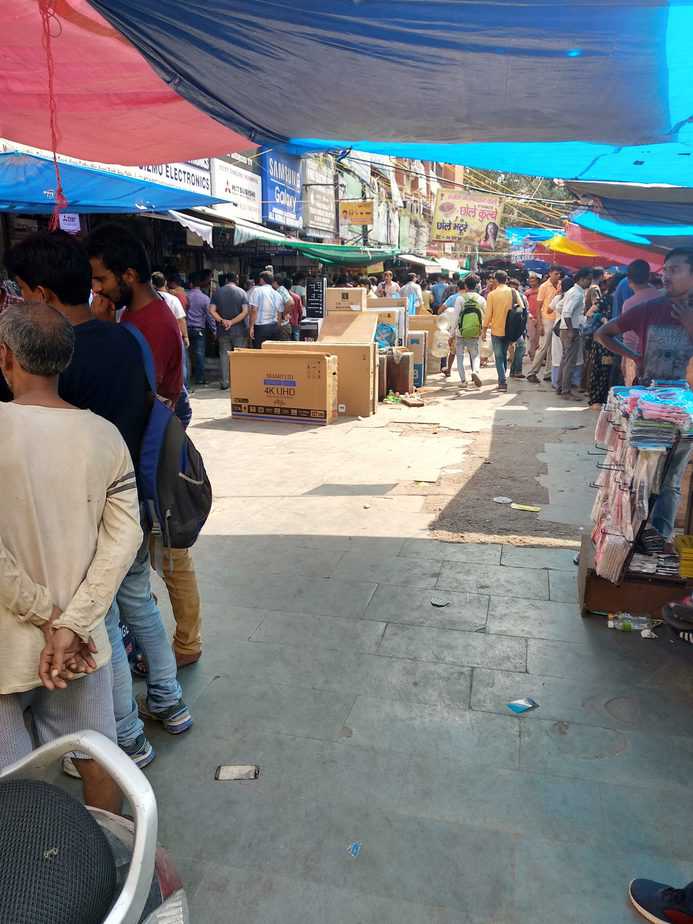Karol Bagh’s Gaffar Market is notorious for its low-priced electronics. TV sets and mobile phones are sold without bills, but strangely they all come with a warranty
Remember seeing those fancy LED TVs in mega electronics stores? Also, do you remember the hefty price tag on it, which stops you from asking further questions from the salesman? Then the salesman tries to lure you into buying that 50-inch LED TV by explaining all its smart features.
This is what one might typically experience while buying an LED. But in Delhi’s Gaffar Market, this experience might be strikingly different.Just when you get down the rickshaw in the blazing heat, a huge board welcomes you to Gaffar Market. As you enter the market, the countless mobile repairing stalls are overwhelming, like the options at an ice-cream parlour.
A plethora of compact stalls, some of which have wheels too, take up most of the walking space on the main lane of the market. Dominated mostly by the Sikhs, the mobile repairing market leads you to the main attraction of the Gaffar Market — the TV and iPhone lane, as one guy calls it while explaining the directions.
The entire open compound is filled with mobile repairing shops, with boards saying ‘Jailbreak iPhone’, ‘Unlock any iPhone’ and ‘Repair iPhone and iPad.’ Men sitting next to each other in crammed stores, call you and ask “Sir mobile repair karwana hain”, “iPhone hai? Jailbreak karwana hain?”.
Just when you try to ignore them, your gaze stops at cartons which appear to be LED TVs of brands like Samsung and Sony.
A man in his 30s who stands under the roof of a shop, guarding these television boxes, asks “Sir Sony ya Samsung?”.
He quotes a price, which leaves you shocked, “Samsung 49-inch smart LED for Rs 43,000.” How is a 49-inch LED TV being sold for Rs 43,000? He also says that no bill will be provided. You are taken aback with an unsettling feeling as you try to judge the television set. Is he taking you for a ride?
He then tries to reassure you that the television is brand new and if you want, a warranty can be provided.
You’re in a confused state now. If he is not willing to give the bill or any proof of purchase, then how can he boast about the warranty? You try to enquire about it and , then he explains that the warranty will be provided by another man, with whom the shop has a tie-up.
He again starts explaining the prices of warranty as it varies from TV to TV. For a Samsung 55-inch Ultra HD LED TV, the warranty price is set at Rs 7,000, and a 49-inch LED of the same brand will cost Rs 5,100, and the deal stealer is that it’s for three years.
At another shop, a man who is standing at the entrance, resting his hand on a mountain of television boxes, says that his shop offers warranty from Samsung, but he won’t provide the bill.
“Bill ka kya karoge warranty toh mil rahi hai na (What will do you with the bill when you are getting the warranty?),” he asks with compelling logic.
But another shopkeeper refutes this claim, saying that the warranty being provided by the shops here is from a third party only and not the television companies.
If one buys a television set from here, a warranty card will be made and on-site warranty will be provided, which is valid across India. Another shopkeeper says that this idea to provide third party on-site warranty was started 3 to 4 years ago, when it became a major concern among buyers.
A customer jumps into this conversation and asks, “Aapne pehle liya hai tv yaha se?” He is confused about whether he should buy or not, but the shopkeeper reassures him, and says that he will give him small demo on one condition — that first a verbal confirmation is required from the customer only then he can open up the sealed television box.
The customer, after giving it a thought, agrees and fixes his gaze at the television box which has a 43-inch LED TV for which he agreed to pay Rs 34,000. The shopkeeper opens the box, pulls out the television set from the box and turns it on. An Asian lady is dancing on the screen and the quality is HD, the customer finds it amusing and feels happy about his purchase.
Suddenly, another question comes up — where do they get these televisions from if they don’t have the bill? “We mostly get these imported from Dubai and Bangkok,” says a shopkeeper.
As he tries explaining the process. “We have distributors in these countries who send us the television sets according to the demand,” he adds, requesting anonymity.
“The market has become very slow and it is not how it used to be 3-4 years ago,” he says. He sells about 15 to 20 units in a day, whereas earlier he used to sell almost 30 in a day. Even though 15-20 pieces in a day seems like good business, but not to him.
He further says, “Ab toh online bhi kaafi sasta mil jaata hai, log aate hai par utne nahi (Nowadays, everything is available online at cheaper rates. So, not many people buy from this market. But we still have customers.)”
Interestingly, Gaffar Market was also listed as ‘one of the world’s worst for pirated goods’ in a report released by the US Trade Representative, along with other markets in India like Nehru Place and Manish Market in Mumbai. The report also said that vendors in these markets “are successful at hiding illicit merchandise prior to police raids and returning it to shelves shortly after”.
By going by the sight of television sets placed openly in the middle of the compound in Gaffar Market, this reality hardly seems to affect the shopkeepers. Wasn’t GST supposed to prevent such shady deals?
On the US Blacklist
In a 2017 report published by the Office of United States Trade Representative, Gaffar Market was listed amongst the notorious markets across the world.
This is not the first time the market was included in the report by the USTR. Since 2011, Gaffar market has been under the radar of the USTR, and is being listed every year since 2011 as a market where counterfeit goods are being sold freely in an open space.
Not only Gaffar Market, but other markets such as Manish Market and Lamington Road in Mumbai, which are semi-organised markets are also being included in the list.
The report says, “Several previously identified markets because owners, operators, and governments failed to address previously stated concerns.”
Delhi’s Tank Road market in Karol Bagh returns to the list in 2017. Stakeholders confirm that it remains a market selling counterfeit products, including apparel and footwear. Counterfeit products from Tank Road are also reportedly found in other Indian markets, including Gaffar Market and Ajmal Khan Road.
Gaffar Market also is a place for jailbreaking — a term used by techies to unlock an iPhone authorised to be sold in a particular country.
One shopkeeper refused to say a single word when he was asked about jailbreaking — he expected to be shown the phone first before he talked about it. Whereas another shopkeeper, after much persuasion, quoted a price of Rs 1,000 for jailbreaking an iPhone 7 brought from the US.





